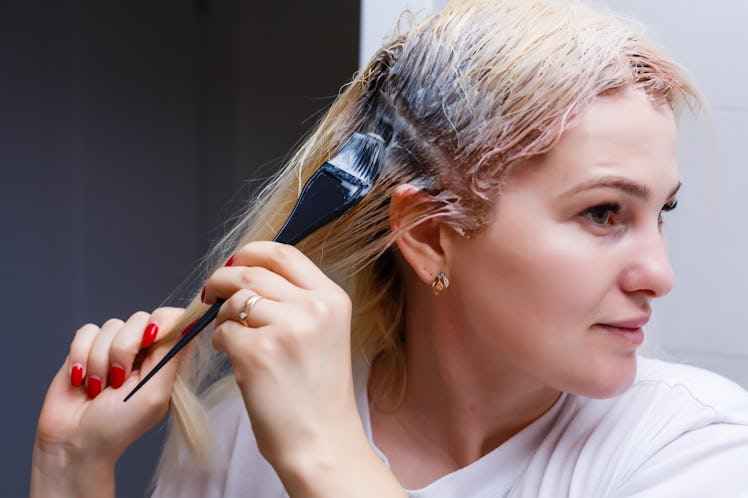
Before You Full-On Panic, Here's How To Fix An At-Home Hair Color Gone Wrong
To quote iconic pop star Hannah Montana, “Everybody makes mistakes. Everybody has those days.” If that lyric relates to one of your DIY hair dyeing experiences, that’s not great. Sadly, there are a plethora of ways you can mess up dyeing your hair, particularly because this is a complicated process that should, most times, be left to a professional. From bleached hair ending up brassy to the color being not exactly what you hoped for an overall patchy job, there are a lot of things that can go wrong. Luckily, I tapped a few experts for tips on how to fix hair color mistakes.
I’ve given myself countless bad hair dye jobs. Sometimes, it’s as simple as just missing a huge chunk in the back (which is why you should try to have someone help you), but sometimes, the color is not at all what the box promised, and I just wish I could go back to square one. But before you plop even more dye on your head to fix things, heed the below advice from colorists to help you out of any hole you’ve dug yourself into.
“I do not recommend anyone to take on a color correction at home, I have seen way too many mistakes, and I have had to fix numerous of them,” Stephanie Santiago, a New Jersey-based colorist tells Elite Daily. Instead, she says the best way to gently fix a hair color mistake is to use a clarifying shampoo, like Kristen Ess’ Deep Clean Clarifying Shampoo ($12, Target). “Using a clarifying shampoo once or twice a week will help break down the color molecules, making your hair fade faster. Know this method will only lighten your hair a shade, at most two lighter,” Santiago tells Elite Daily.
If your DIY hairdo just came out a bit patchy, things look slightly less bleak. “If your color comes out patchy, then you can just reapply [the dye]. You can spot paint or put [the dye] over the whole head, but it will make the parts already painted more opaque or saturated,” says L.A.-based hairstylist Jill O’Neil. “With bleach, only apply to the spot missed, and if it isn’t in an obvious place, once you tone, it shouldn’t be very noticeable your dye job comes out patchy.” If you haven’t started your process and would like to avoid patchiness totally, Santiago recommends giving yourself a good chunk of time to apply the dye in smaller sections.
If you tried your hand at bleaching your hair, you may have ended up looking a bit brassier or orange than intended. For that, both experts suggest using toner to get closer to the color you actually wanted. If your hair came out looking more gold, go for a purple-based shampoo and conditioner. For brassiness or orange, try a blue-based combo. And if your hair is unexpectedly looking more green, O’Neil suggests using ketchup. “Crazy, I know, but think [of the] color wheel.”
For a botched highlight look, fixing that’s a little harder. Unfortunately, you’ll probably have to re-highlight your hair, but, overall, you need to tread super cautiously to avoid damaging your hair even more. “If it happens, you can tone the highlights two to three shades darker, and it will blend the stripes out,” O’Neil says. “This one is really tricky and could cause more damage.” If you want to avoid hurting your hair, Santiago suggests adding a shadow root by applying the darker toner to just your roots for a more lived-in, natural look.
All in all, the experts recommend giving yourself a lot of time to complete any hair dyeing job and never using a 40-volume bleach developer, no matter how light you want to go. And you might consider reaching out to your hairstylist to see if they’re offering virtual walkthroughs. Remember, even with all the tutorials in the world, mistakes can happen. If they do, before you stress out, take a deep breath and remember, there are ways to make it better without totally ruining your hair.
This article was originally published on